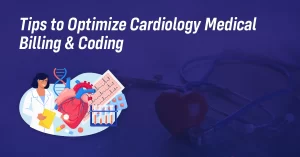Urgent care centers, medical billing, and medical coding play a crucial role in the operations of urgent care clinics. Inaccuracies in these areas can have significant consequences, impacting the productivity and profitability of the practice. Imagine the scenario where an ambulance service promptly responds to an emergency, but records incorrect details in their report. This can lead to billing errors and non-payment, akin to providing critical services for free. Despite diligent efforts, such paperwork inaccuracies pose challenges to the overall profitability of urgent care centers.
According to research conducted in 2023, urgent care clinics handle approximately 89 million patient visits annually, accounting for 29% of primary care visits and almost 15% of outpatient visits in the United States. These clinics offer efficient and convenient care, with more than 70% of patients waiting less than 20 minutes to see their providers, and 85% being treated within an hour.
Now, let’s delve into the essential updates regarding urgent care billing and coding guidelines. The coding and reporting guidelines rely on the International Classification of Disease, 10th Revision, Procedure Coding Systems (ICD-10-PCS). This system classification is used in hospital inpatient healthcare settings to classify various ICD procedures. It is mandatory to adhere to the Health Insurance Portability and Accountability Act (HIPAA) when assigning ICD-10-PCS procedure codes.
Medical Billing & Coding Guidelines 2024
The 2023 medical billing and coding guidelines contain precise key points to acknowledge. Medical billers and coders, particularly those working in urgent care centers, must stay up-to-date on the latest guidelines to ensure they accurately code medical services. These guidelines hold significant importance for urgent care centers as they help ensure that patients receive the reimbursement they deserve, while healthcare providers are not overpaying for services.
The Centers for Medicare and Medicaid Services (CMS) has specifically updated the Place of Service (POS) code for urgent care centers to 20. This change in guidelines directly impacts the coding and billing practices of urgent care centers.
There are updates in Evaluation and Management (E/M) codes specifically tailored for urgent care visits. These codes are essential for depicting the level of care provided by healthcare providers and ensuring consistent reimbursement rates.
To reduce errors in claim submission, CMS has implemented a new policy emphasizing “Electronic Claim Submission.” This updated implementation carries additional significance due to the streamlining of the claim submission process.
Now let’s delve into some precise aspects of the guidelines:
➜ The ICD-10-PCS codes, comprising “7” characters, provide precise information about every procedure performed. Each character plays a specific role in coding accurate details.
➜ For multiple procedures performed during the same operational episode, if the same root operations are carried out on various body parts, they must be appropriately coded.
➜ Biopsy procedures should be coded using the root operations Excision, Extraction, or Drainage, along with the qualifier Diagnostic.
➜ Bypass procedures require identifying the body part bypassed “from” and the body part bypassed “to” for accurate coding.
➜ While no longer used for E/M services, history, and exams are still essential components when reporting CPT codes 99202-99215. E/M code selection now depends on the medical decision-making (MDM) level and the time spent on the encounter day.
➜ The time associated with CPT codes 99202-99215 has shifted from typical face-to-face time to the total time spent with the patient on the visit day.
➜ The MDM associated with codes 99202-99215 now includes three updated components: 1) The number and complexity of problems managed 2) The amount or complexity of data reviewed and analyzed 3) Risk of complications or mortality of patient management. Selecting an E/M service level requires meeting or exceeding two of these elements.
Urgent Care Billing and Coding Process Know How
In the context of urgent care facilities, the process begins as soon as patients step in through the front door. The entire cycle is carefully crafted, starting with the establishment of a concise and coherent urgent care billing and coding policy.
While the walk-in nature of urgent care appointments may lead some facilities to overlook the pre-registration process, it is still important to gather fundamental patient data. Clinical receptionists collect information such as the patient’s name, address, date of birth (DOB), purpose of visit, policy numbers, primary care providers, and insurance details.
During the registration phase, all patient health information is compiled in Electronic Health Records (EHR). This efficient management of patient records by utilizing EHRs saves time and contributes to smooth operations and simplified processes within urgent care facilities.
The primary objective of optimizing the billing and coding process is to increase revenue while reducing expenses associated with high-cost collection procedures. Don’t let cumbersome billing and coding processes cause delays in revenue generation. Consider outsourcing urgent care medical coding and billing to Bell MedEx as an alternative to in-house management and experience the difference it can make.
By emphasizing efficient urgent care billing practices and leveraging the expertise of external service providers, urgent care facilities can streamline their revenue cycle management and ensure timely reimbursements.
Exclusive ‘S’ Codes for Urgent Care Facilities
Both urgent care and primary care facilities treat many of the same health issues, so they often use similar billing and coding systems. But there’s a special code that starts with the letter ‘S’ that is unique to urgent care facilities. These ‘S’ Codes belong to the Healthcare Common Procedure Coding System (HCPCS) and are now recognized by many Healthcare providers.
S9088
Urgent care providers use Code S9088 to bill for the evaluation and treatment of medical conditions. They should use this code in conjunction with an appropriate Evaluation and Management (E/M) code.
S9083
On the other hand, code S9083 covers a fee for any services provided, regardless of the type of treatment a patient receives. However, due to its reliance on a global fee scale, it results in the same reimbursement for both minor and major cases. Specific Managed Care Organizations (MCOs), particularly in states like Florida and Arizona, may mandate using this code.
While S9088 and S9083 codes are suitable for most urgent care visits, Medicare uses codes based on established medical necessities and geographic location. Upon concluding a patient visit, a coder will document all diagnoses and procedures using standard medical codes, such as the ICD-10.
Urgent Care CPT Codes Category
✅ In urgent care billing, the primary focus is Category 1 CPT (Current Procedural Terminology) codes. These codes cover a wide spectrum of healthcare services, including evaluating and managing diseases, the execution of surgical procedures, radiology services, pathology evaluations, lab tests, medicine prescriptions, and anesthesiology services. These codes summarize most services rendered in an urgent care setting, making them integral to the billing process.
Other Used CPT Categories
❌ While less central to urgent care, Category 2 CPT codes still carry relevance. They serve as optional performance measurement tools that provide an extra layer of quality assurance. They don’t replace Category 1 CPT codes but rather supplement them, offering additional metrics for assessing the quality of patient care.
❌ Category 3 CPT codes are less commonly utilized within urgent care facilities. These codes are designated for emerging technologies, services, and procedures still obtaining full FDA approval.
Common Urgent Care CPT Codes
A significant portion of the CPT codes utilized in urgent care come from Category 1, specifically evaluation and management codes (E/M). These codes are central to urgent care billing, as they facilitate the billing for a wide array of patient encounters, from minor to major cases. These codes enable urgent care facilities to accurately and effectively bill for their services, thereby streamlining their operations and ensuring the sustainability of their practice.
99214
This code refers to the clinic or outpatient evaluation and management of an existing patient who requires two of three components: a detailed examination, moderate complexity medical decision-making, and a comprehensive patient history.
99213
Patients needing treatment with low complexity use code 99213, which can be upgraded to 99214. Healthcare providers often use this code because it has more accessible reimbursement criteria, even though it does not provide as much reimbursement as code 99214.
99204
Healthcare providers generally use this code for new patients in urgent care, as it requires three criteria: conducting a comprehensive patient history, performing a thorough exam, and making medical decisions of moderate complexity. Code 99204 offers a significant reimbursement rate but also has a similar non-compliance rate.
FAQs
How do the updated guidelines impact reimbursement for urgent care services?
The updated guidelines impact reimbursement for urgent care services in a few ways.
- The new codes for telehealth services will allow urgent care providers to bill for these services more accurately and efficiently.
- Updating the E/M coding guidelines will allow providers to bill for the appropriate level of care.
- Changes to the modifier usage guidelines will help ensure that providers accurately report the services they provide.
What documentation and coding best practices should be followed to ensure compliance with the new guidelines?
To ensure compliance with the new guidelines, urgent care providers should follow the following documentation and coding best practices:
- Document the patient’s primary complaint and history of present illness in detail.
- File the physical examination findings in detail.
- Document the diagnostic tests and results.
- Document the treatment plan and the patient’s response to treatment.
- Use the appropriate CPT codes and modifiers to report the services provided.
What are the consequences of upcoding or downcoding in urgent care billing and coding?
The consequences of upcoding or down coding in urgent care billing and coding can be significant. Upcoding, which is the practice of billing for a higher level of service than was provided, can result in fraud and abuse charges. Downcoding, which is the practice of billing for a lower level of service than was provided, can result in lost reimbursement.
How can urgent care providers ensure compliance with the Health Insurance Portability and Accountability Act (HIPAA) when coding and billing for their services?
Urgent care providers can ensure compliance with the Health Insurance Portability and Accountability Act (HIPAA) when coding and billing for their services by following the below listed best practices:
- Obtain the patient’s consent before disclosing any protected health information (PHI).
- Use strong PINs and security measures to protect PHI.
- Only share PHI with authorized folks.
- Proper assortment and protection of PHI (Protected Health Information).
Bottom Line
It’s vital for urgent care clinics, as the primary focus, to grasp the latest CPT code changes in 2023. These changes impact how these clinics handle medical billing and coding, making it of utmost importance for them to stay well-informed for accurate reimbursement. Here are some dedicated resources that can assist urgent care clinics, particularly:
- The American Medical Association (AMA) provides a comprehensive guide on its website, specifically tailored to urgent care clinics.
- The Centers for Medicare and Medicaid Services (CMS) publish a yearly guide, which includes specific updates relevant to urgent care clinics.
- Active participation in online medical coding forums and communities can offer valuable insights and guidance tailored to the unique challenges faced by urgent care clinics.
To stay ahead of the game and avoid costly mistakes, urgent healthcare providers operating within these clinics should:
- Remain proactive in staying up-to-date with the latest CMS regulations that specifically impact urgent care clinics.
- Implement and leverage a certified Electronic Health Record (EHR) system, purposefully designed to streamline the intricate processes of medical billing and coding in urgent care settings.
- Seek specialized assistance from certified medical billers and coders, who possess the expertise and experience to navigate the complexities of claims management within the context of urgent care clinics.
By prioritizing these measures, urgent care providers can ensure accurate reimbursement and maintain strict compliance with the most current billing and coding regulations that are vital to the success of their clinics.




